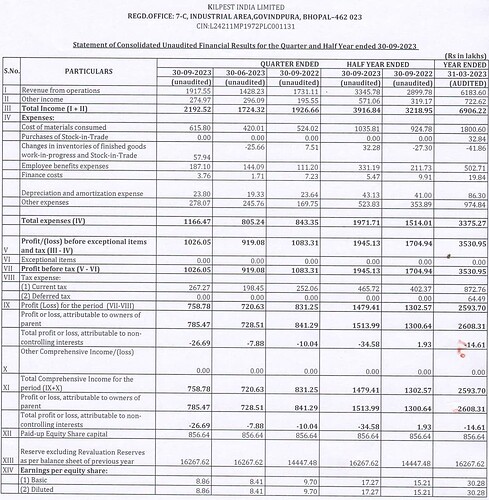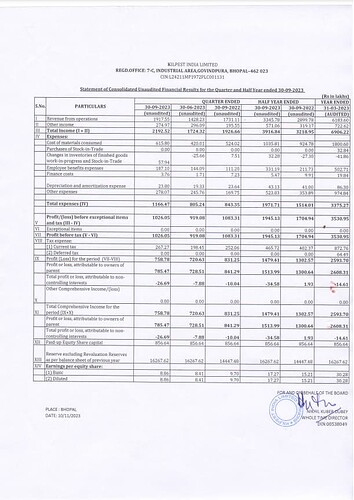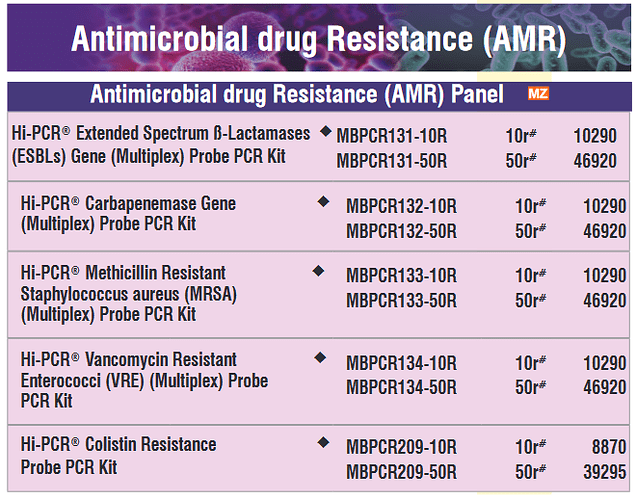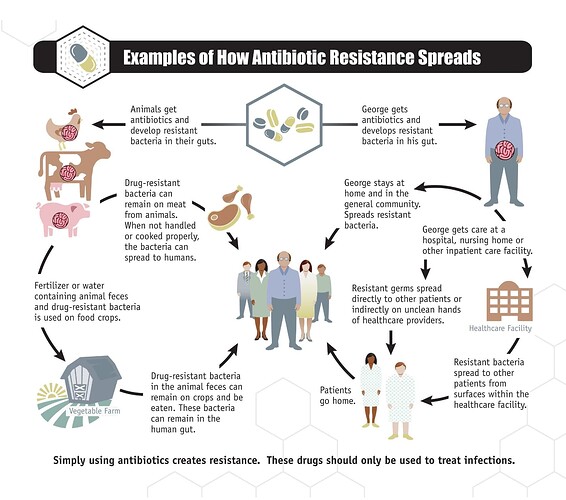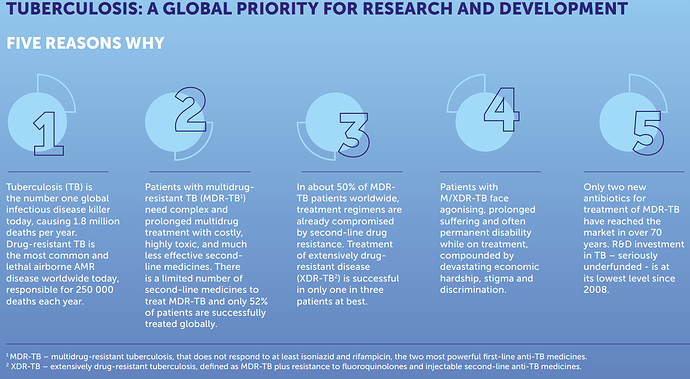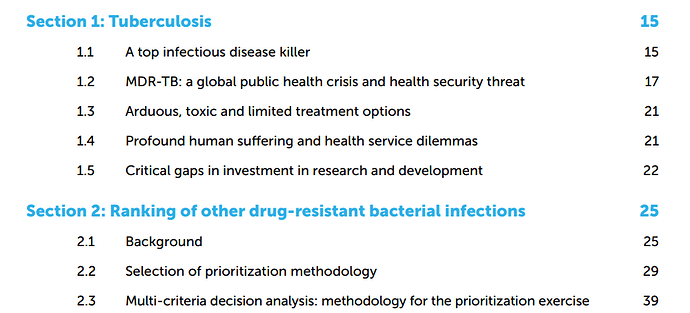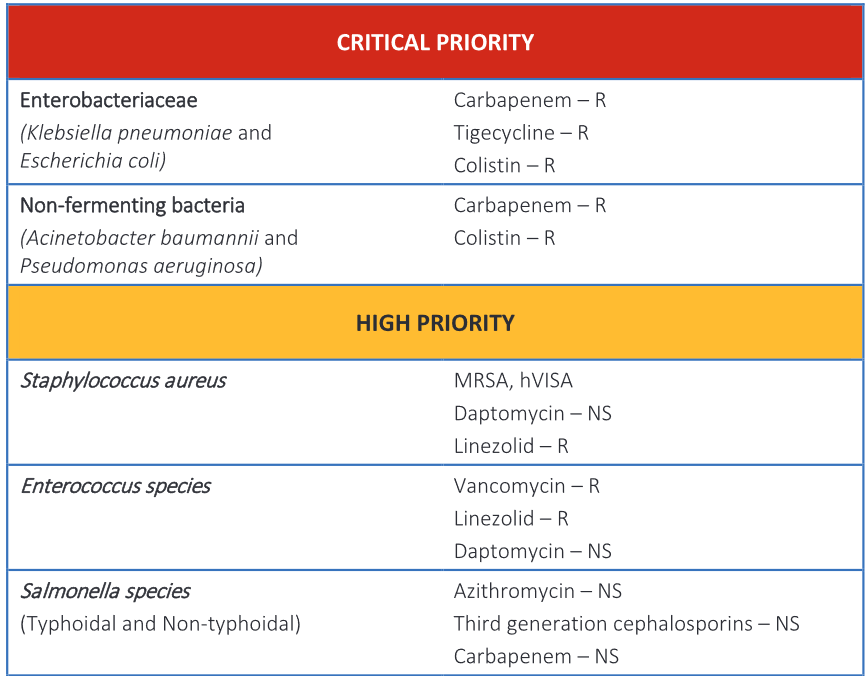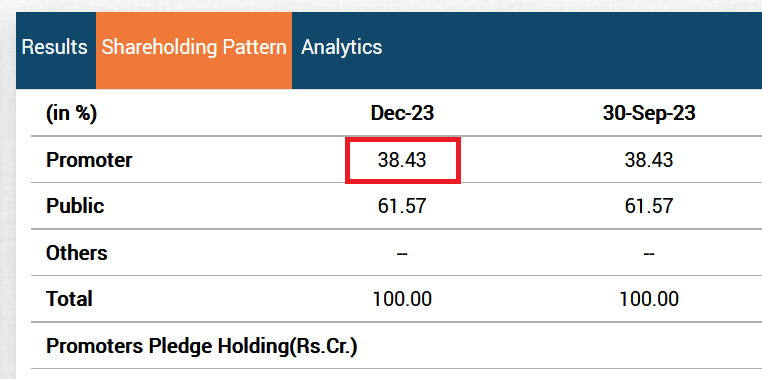I haven’t read the article (not a subscriber). Would be grateful if someone can share a summary, especially any insights outside of the recently published Nuvama report.
https://www.bseindia.com/stockinfo/AnnPdfOpen.aspx?Pname=d974e280-5a02-40cb-8f87-34426970d495.pdf
And
https://www.bseindia.com/stockinfo/AnnPdfOpen.aspx?Pname=55d3303e-27c1-431f-b8f4-b16113314fbd.pdf
Consolidated Financial Results: The consolidated financial results include the performance of Kilpest India Limited.
- Revenue from Operations: The consolidated revenue from operations for the quarter and half-year ending September 30, 2023, was Rs 1,977.55 lakhs, showing an increase compared to the same period last year, which was Rs 1,737.13 lakhs.
- Other Income: The consolidated other income was Rs 274.97 lakhs for this period.
- Total Income: The total income for the quarter and half-year ending September 30, 2023, was Rs 2,192.52 lakhs.
- Expenses: The total expenses for the consolidated financials amounted to Rs 1,166.47 lakhs, which include costs like material consumption, employee benefits, depreciation, and other operational costs.
- Profit Before Tax: The profit before tax for this period was Rs 1,026.05 lakhs.
- Exceptional Items: There were no exceptional items reported for this period.
- Profit After Tax: The profit after tax for the quarter and half-year was Rs 758.71 lakhs.
- Earnings per Equity Share: The earnings per equity share for both basic and diluted calculations were Rs 8.86.
Looks like the name change has gone into effect in some places but not everywhere — screener shows “3D Blackbio…” but the BSE website still shows Kilpest
^ AMR poses a significant threat to public health. Kilpest recently came out with a TRURapid test for AMR (details in the latest investor presentation). From a quick Google search it looks like Kilpest is the front runner and possibly the only India based manufacturer. Not sure how big is the market size and how complex is it to make a test like this.
Disc.: invested
That’s the wrong name. Hope the multi-year long battle of amalgamation, name change and listing will soon be over with the correct name.
Edit: The wrong name doesn’t seem to do with BSE but it is only on Screener.
Disclosure: invested
Do we have an understanding of the price set for this AMR test by 3B BlackBio? Since they will sell the product to diagnostic labs and hospitals, i am curious what price they would be quoting
I don’t have any info on what 3B’s price for AMR kits is.
Here is something I found from HiMedia:
Himedia Pricelist 2023-24 (page 682)
~
However, I was doing some research on AMR and here is what I have found so far:
What is antimicrobial surveillance?
-
Antimicrobial surveillance refers to efforts to monitor changes in populations of microbes to help understand evolving patterns of resistance to anti-infectives. It can be conducted on a global, regional, local country, or healthcare facility basis.
-
Low-income countries are particularly vulnerable to AME because of conditions that enable the spread of these diseases, such as poor sanitation, lack of control of and guidance on antibiotic use, inadequate healthcare services and systems, and limited or inadequate infection control measures.
-
Middle- and upper-middle-income countries are not free of the burden of drug resistance, however. BRICS countries (Brazil, Russian Federation, India, China and South Africa) and several European countries face major epidemics of multidrug-resistant infections caused by common Gram-negative bacteria and multidrug-resistant-TB (MDR-TB), with devastating public health and economic consequences.
-
Gram-negative bacteria are much to resistant to anti-biotics compared to gram-positive bacteria
-
Sadly, the pipeline for new antibiotics currently includes only a small number of novel compounds in development. In the past 20 years, only two new antibiotic classes, both active only against Gram-positive bacteria, have received global regulatory approval by international regulatory agencies. In the same time period, no new antibiotics against Gram-negative bacteria have been approved. In addition, only two completely new drugs for MDR-TB treatment (bedaquiline and delamanid) have reached the market in over 70 years.
Why is surveillance crucial?
Antimicrobial resistance (AMR) occurs when pathogens change and find ways to resist the effects of anti-infectives. AMR, particularly in Gram-negative bacteria, is widely recognized as one of the biggest threats to global public health today; causing 700,000 deaths annually.
Surveillance is a vital tool for clinicians and public health officials to slow the rise of AMR:
- Providing early warning of emerging threats and helping decision-makers intervene before they escalate.
- Guiding public health policy and infection prevention and control plans.
Examples of how AMR Spreads
Market Size
- The Global Antimicrobial Resistance Surveillance Market Size was valued at USD 5.61 Billion in 2022. The Market Size is projected to grow at a CAGR of 5.8% from 2022 to 2032
and is expected to reach USD 9.92 Billion by 2032 Asia Pacific is expected to Grow the fastest during the forecast period [Global Antimicrobial Resistance Surveillance Market Size - 2032.]
AMR and TB
- This WHO report on AMR has two sections – one dedicated to TB and another to other drug-resistant bacterial infections. What I infer is TB has much more importance than others bacterial infections [Prioritization of pathogens to guide discovery, research and development of new antibiotics for drug-resistant bacterial infections, including tuberculosis]
-
Drug-resistant TB is now estimated to be responsible for 1/3 of all deaths due to antimicrobial resistance (AMR)
-
Tuberculosis is a bacterial infection caused by species of the Mycobacterium tuberculosis (TB, MTB) complex. A drug resistant strain is defined as resistance to at least one primary drug used to treat tuberculosis. A multidrug resistant TB (MDR-TB) is defined as resistance to at least isoniazid and rifampicin, the two most effective anti-TB drugs, and an extensively drug resistant TB (XDR-TB) is defined as a MDR-TB strain with additional resistance to any fluoroquinolone and at least one additional Group A drug. In 2022, it was estimated that approximately 4% of incident new TB cases in the world had MDR/RR-TB1.
-
MTB RIF/INH resistance test provides identification of rifampicin (RIF) resistance and isoniazid (INH) resistance targeting rpoB, katG and inhA genes
AMR and MRSA
- The world learned of the dangers of antimicrobial resistance with the rise of hospital-acquired infections, like methicillin-resistant Staphylococcus aureus (MRSA). MRSA is a bacterial infection which causes the same infection as SA, however it is dangerous due to its resistance to many antibiotics that successfully treat normal SA.
3B BlackBio Dx’s offerings
- 3B BlackBio Dx has the following AMR kits available [see their website]. “3” and “4” are related to TB. Good to see the focus on TB.
(1) UTI AST Panel Kit
(2) MRSA Detection Kit
(3) Rif/INH MTB Drug Resistant Detection Kit
(4) Rifampicin Resistant MTB Kit
Competitive Landscape
-
For Rif/INH MTB Drug Resistant Detection Kit I could find only Abbott and Roche having the kits apart from 3B [RealTime MTB RIF/INH Resistance Assay | Abbott Molecular , cobas® MTB-RIF/INH]
-
For Rifampicin Resistant MTB Kit I see Molbio and Cephid have kits in addition to Abbott and Roche [Molbio Diagnostics Pvt. Ltd., Xpert® MTB/RIF Ultra]
Indian Priority List
Some notes on antibiotics (taken from ‘The rise and fall of modern medicine’ by James Le Fanu)
-
The discovery of penicillin is most definitive moment of the modern therapeutic revolution
-
At the core of antibiotics lies an unresolved mystery: why should just a few species of micro-organisms produce these complex chemical compounds with the capacity to destroy the full range of bacteria that cause infectious disease in humans?
-
After the discovery Alexander Fleming did not take his research further because he did not think it was worth pursuing, ‘a good example of how preconceived ideas in medicine can stifle the imagination and impede progress’. So the near miraculous properties of penicillin had to be rediscovered all over again ten years later by Howard Florey and Ernst Chain in Oxford:
-
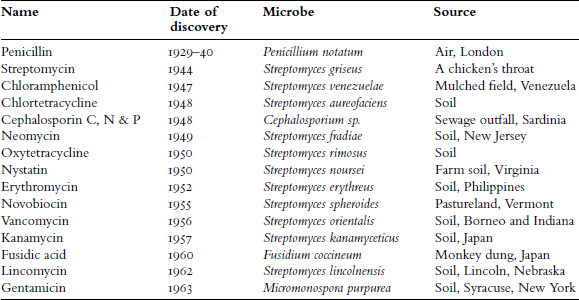
-
Come the end of the war, in 1945, Florey and Chain shared, along with Fleming, the Nobel Prize. Their achievement was not just the development of penicillin but rather the clarification of the principles by which all antibiotics were subsequently to be discovered. Florey, in his acceptance speech, spelled them out: first, the screening of microbes to identify those that produced an antibacterial substance; then, the determination of how to extract the substance; then testing it for toxicity and investigating its effect in animal experiments. And finally, tests in humans.
-
The screening of tens of thousands of species of micro-organisms over the next few years revealed a handful that produced a whole further range of antibiotics.
-
The chemistry of antibiotic molecules is very unusual. It was hoped in the early days following the discovery of penicillin that the drug could be synthesised, thus avoiding the necessity of growing the penicillium mould in vast fermentation plants. But that was not to be.
-
It seems inconceivable that bacteria, the simplest of organisms, should have the ability to produce such complex molecules (antibiotics) which serve no purpose in their survival. This remains a deep mystery.
This post is WIP – will add more stuff in the coming days
For MRSA and AST I am still on with my research
This is excellent information, Apurva. Thank you for sharing.
Funding for the fight against TB is expected to pick up soon too, this has been discuased to a certain degree in Gujarat Themis concalls as they manufacture APIs for the Rifa chain. I’d infer that some should channel itself into AMR diagnostics for TB as well.
https://www.bseindia.com/xml-data/corpfiling/AttachLive/057c94d7-5e91-462f-9103-22c2257cb67e.pdf
A good Q3 result in my view – growth continues. I had expected a bit more from the Manchester facility.
Disc.: invested
Growth rate Should be speed up from here in diagnostics division due to lower base as whole industry is growing at faster rate…
Good Part is management commentary is also positive in agrochem division which may provide double engine growth going fwd…
Disc: Invested
Enen though name change and sector change ( from crop protection to healthcare) has been corrected in the BSE page of 3 B BlackBio Dx Ltd., the following values- EPS (TTM), CEPS (TTM), PE, PB and ROE are wrongly displayed on the BSE page.
The values are based on the standalone financials of Kilpest India Limited. To represent the true value of the company to the public, somehow this error is to be corrected by bringing in the attention of BSE.
Similarly 3 B BlackBio Dx Ltd. is still categorized as a crop protection products company in majority of the portals like The Economic Times, Money control, Tickertape, Mint, MarketsMojo and similar ones.
The company is tabulated among crop protection products companies in the peer group section of all these portals.
In 9 months ended on 31.12.2023, 82% of revenue and 94% profit before tax are from diagnostic segment.
These are to be corrected somehow to get a true picture of the company to the investing community.
https://www.bseindia.com/stock-share-price/3b-blackbio-dx-ltd/3bblackbio/532067/
Disclosure: Invested
While the points you make are true, I don’t think they are holding back the discovery of the company. I also don’t think the market misunderstands the nature of the company’s business/ operations. I make this statement basis following:
1. The company, in its earlier avatar of Kilpest, was able to get US FDA approval for RT PCR kits, and was promptly recognized and rewarded by market.
2. The company has been meeting analysts and other investment firms/community from time to time.
3. Though the company doesn’t do concalls, the presentation all through has been giving enough information to decipher COVID and non-COVID revenue.
4. The market has also realized the one-time nature of COVID revenue, with the company being valued at 2-5 PE basis peak profitability in the past.
5. Above all, in a bull market, when people are searching for reasonable opportunities, a company of such nature (by financial numbers) is sure to pop up in screeners and is unlikely to escape attention.
The one-time rerating (from 300-400 odd levels to 850 odd levels) for the company is done and dusted, IMO.
Further performance trajectory would mainly depend on the following:
1. Utilisation/Misutilisation of the cash reserves.
2. Earnings growth.
3. Ability to tap into the opportunities thrown open by UK subsidiary.
Healthcare sector commands a median PE of 40 or above. 3BBDx has not yet scaled that number. May be due to the lack of discovery by retailers.
Couple of other things that are incorrect on the BSE website:
1/ Shareholding: promoter holding should be ~41% post amalgamation.
2/ Market Cap is incorrect: it doesn’t reflect the effect of amalgamation correctly – based on today’s price of 913 it shows a mcap of 685 CR. I believe it should be 776 CR instead (i.e., 685 * (85/75)) because the number of shares should have increased from 75L to 85L post amalgamation
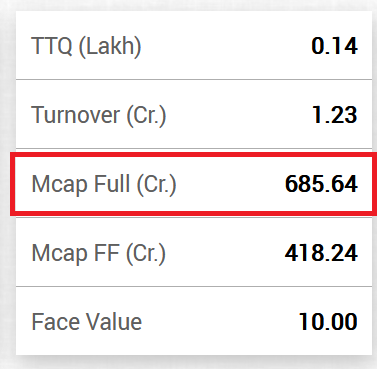
The amalgamation formalities completed in Dec’23 so I am not sure why it didn’t reflect in BSE’s shareholding pattern data which was published on Jan 9th 2024:
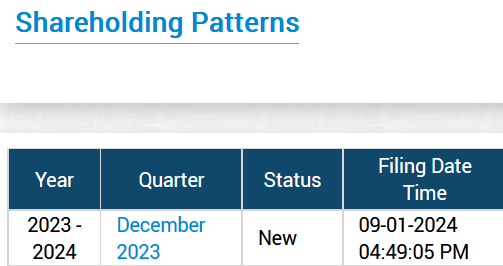
Good observations. In the Statement of Standalone Unaudited financial Results for the Quarter and Nine Months ended 31-12-2023, item no. XII, paid up capital is recorded as 856.79 lakhs.
https://www.bseindia.com/xml-data/corpfiling/AttachHis/057c94d7-5e91-462f-9103-22c2257cb67e.pdf
Hence no. of shares: 85.679 lakhs?
Meanwhile, such wrong exhibits in portals of BSE and other media conveys the fact that ML and AI systems relied on by such portals should be more efficient and needs improvement at this time. It also indicates that diligent number crunching is necessarily needed for serious investors. Most probably it may bear fruit in long run if system is stable.
Looks like 3B is launching a new line of products – dPCR
Choosing dPCR vs qPCR – Explore the benefits and see if it’s right for your research goals
When comparing dPCR vs qPCR technologies, the key difference is precision power. While both offer highly sensitive and reliable nucleic acid detection and quantification, the key difference between the two technologies can be best described using an analog versus digital radio analogy, says Dr. Jim Huggett, Principal Scientist, National Measurement Laboratory. “With an analog radio, the dial must first be fine-tuned to get the desired station with the least interference. Still, the quality depends on reception and the signal is subject to interference from static. This is qPCR. It is reliable but requires optimization to get a good result, and even then, you must contend with background noise. With digital radio, you simply call up the station and it is either there, with a clear signal, or not. The latter is like dPCR, which provides precise, binary results. It literally counts the presence or absence of DNA molecules. The clarity of results combined with a low error rate makes for an incredibly high level of precision. Digital PCR is well-suited to measure smaller quantitative differences.”


